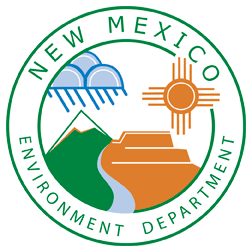Algunas fuentes autorizadas deben demostrar el cumplimiento de la normativa sobre calidad del aire mediante la realización de pruebas de emisiones y el mantenimiento de registros sobre las emisiones a la atmósfera. A continuación encontrará más información sobre estos requisitos y cómo cumplirlos.
Las copias impresas que se presenten de los informes de certificación de cumplimiento anual del Título V y de los informes semestrales de control deben ir acompañadas de un CD o una memoria USB que contenga un único archivo PDF con la misma información que la copia impresa, incluidas las firmas. No incluya ninguna información adicional en el CD o la memoria USB. No se requiere un CD o una memoria USB para las presentaciones de las subpartes (C-G en la sección II del formulario de presentación de informes).
Informes de emisiones y otros informes
- La página web sobre el am ianto describe la normativa sobre el amianto y ofrece formularios reglamentarios al respecto.
- La aplicación Air Quality Bureau Compliance Reporting (AQBCR) se utiliza para enviar electrónicamente el exceso de emisiones y los Informes de Rutina (RR), como las Certificaciones Anuales de Cumplimiento, los Informes Semestrales, NSPS, MACT, las notificaciones e informes de pruebas de apilamiento y los informes NMAC, así como los informes de requisitos de permisos y las notificaciones de puesta en marcha/parada.
- Excess Emission Reporting (EER) proporciona detalles sobre cómo presentar electrónicamente el exceso de emisiones.
- El formulario de presentación de informes permite a las instalaciones presentar copias en papel de los requisitos de información. Consulte las instrucciones del formulario de presentación de informes para obtener información adicional. La JCA solicita que los informes se presenten a través del AQBCR siempre que sea posible; este formulario no es necesario para las presentaciones del AQBCR.
- El formulario de certificación del informe del Título V se utiliza para los requisitos de informe anual y semestral. Consulte las instrucciones y la muestra del informe anual y las instrucciones y la muestra del informe semestral para ver las instrucciones.
- El formulario de presentación de informes ACI se utiliza para documentar el cumplimiento de los requisitos reglamentarios de los incineradores de cortina de aire.
- Gestionar la firma electrónica proporciona instrucciones y alternativas electrónicas y en papel para certificar la identidad para las aplicaciones de NMED que requieren dicha certificación.
Pruebas de conformidad
- Formulario de notificación e informe de la prueba universal
- Procedimientos operativos estándar para la prueba de rendimiento de la unidad de recuperación de azufre
- Procedimiento operativo normalizado para el control periódico de analizadores portátiles
- Centro de Medición de Emisiones Atmosféricas de la Agencia de Protección Ambiental de los Estados Unidos
Informes
- Los informes de exceso de emisiones proporcionan resúmenes de los excesos de emisiones notificados.
Política de sanciones civiles
- La política de sanciones civiles describe las sanciones que disuaden del incumplimiento de los permisos y reglamentos.
Documentación e instrucciones de la norma sobre precursores del ozono (20.2.50 NMAC)
La Regla de Precursores de Ozono(20.2.50 NMAC o "Parte 50") entró en vigor el 5 de agosto de 2022. La regla tiene como objetivo reducir en gran medida las emisiones nocivas anuales de las operaciones de petróleo y gas en Nuevo México. La Parte 50 describe las obligaciones de cumplimiento para las operaciones de petróleo y gas nuevas y existentes en los condados de Nuevo México con altos niveles de ozono. Estos condados son Chaves, Doña Ana, Eddy, Lea, Río Arriba, Sandoval, San Juan y Valencia. Se estima que la norma dará lugar a una reducción de 260 millones de libras de óxidos de nitrógeno y compuestos orgánicos volátiles, junto con un beneficio colateral de reducción de las emisiones de metano en más de 851 millones de libras anuales.
La Oficina de Calidad del Aire se ha comprometido a ayudar a la comunidad regulada a cumplir con esta nueva norma. Con este fin, el personal de la Oficina de Calidad del Aire ha comenzado a realizar talleres para la industria con el fin de ayudar a las fuentes de Nuevo México a cumplir con la nueva norma. Los materiales de las reuniones se pueden encontrar en los siguientes enlaces y se actualizarán periódicamente.
- Preguntas frecuentes sobre la norma relativa a los precursores del ozono
- Plazos de cumplimiento de la norma sobre precursores del ozono
- Directrices de cumplimiento de la norma sobre precursores del ozono
- Guía de la normativa sobre emisiones atmosféricas de petróleo y gas (infografía)
- Presentación de diapositivas de formación de la JCA sobre la norma relativa a los precursores del ozono (octubre de 2022) (con notas del presentador.)
- AQB C & E Formación sobre la Parte 50 # 1 es una discusión de la aplicabilidad de ozono de petróleo y gas, los requisitos generales, los plazos, la vigilancia de fugitivos, y los motores / turbinas.
1 de septiembre de 2022 Taller de la industria:
- Diapositivas de la norma sobre precursores del ozono
- Grabación de la presentación del seminario web sobre la norma relativa a los precursores del ozono (1 hora y 43 minutos) Contraseña: 27vVgJgN
Recursos y herramientas de la norma sobre precursores del ozono
- Plantilla de notificación de datos de cumplimiento de la normativa sobre precursores de ozono. Esta plantilla de informe de datos de cumplimiento contiene toda la información necesaria para incluir en los informes anuales. Este es el formato recomendado por NMED y NMOGA para la presentación de informes. Sin embargo, tenga en cuenta que la norma no exige este formato. Se proporciona por comodidad, coherencia y garantía de que se incluirán todos los datos necesarios.
- Opciones tecnológicas para la recopilación de información de control del cumplimiento. Este documento orientativo se ha elaborado para ofrecer a los propietarios y operadores de instalaciones sujetas a la norma 20.2.50 NMAC una lista de opciones tecnológicas consideradas aceptables para los sellos de hora/fecha/localización de diversas actividades de control exigidas por la norma. La lista es completa pero no exhaustiva. También pueden ser aceptables otras tecnologías, como se explica en el documento.
- OGI-by-drone - Aprobación condicional. Este memorándum describe las condiciones bajo las cuales se aprueba presumiblemente la monitorización con Optical Gas Imaging (OGI) para la Parte 50 cuando los drones llevan la cámara OGI. Esta aprobación presunta, con condiciones, significa que no se requiere un plan de supervisión alternativo para satisfacer los requisitos de supervisión de OGI de la norma siempre que se cumplan las condiciones, incluida la documentación adecuada.
- El formulario de documentación de señalización de tanques de la Parte 50 es el formulario sugerido para documentar el sistema de medición de tanques de almacenamiento utilizado para determinar la cantidad de líquidos en los tanques de almacenamiento y la señalización asociada en cada tanque. Este formulario es opcional y también se aceptan otros formatos de informe.

